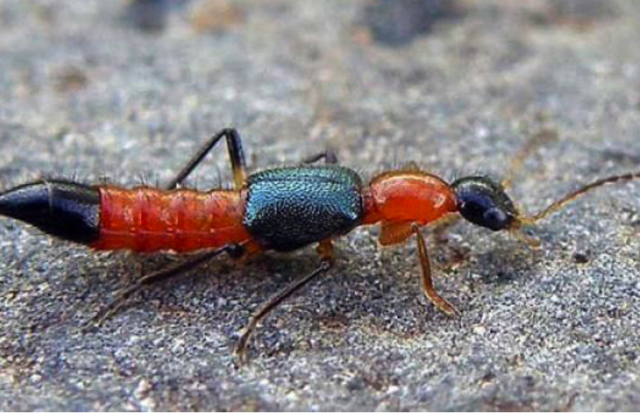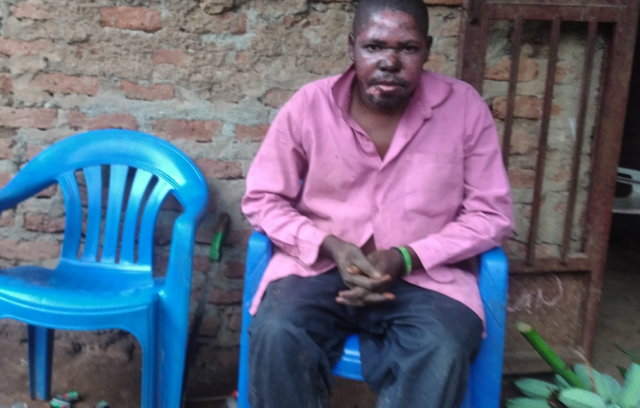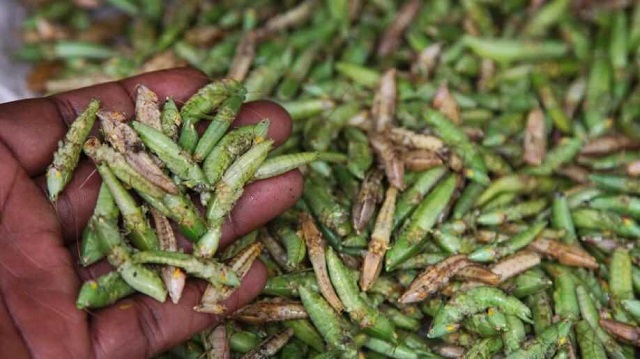
How the Nairobi fly is inflicting pain in the Rwenzori Mountains
SPECIAL FEATURE | RONALD MUSOKE | Bwambale Sibaminya, 49, a peasant farmer from Nyabugesera cell, Ntandi Town Council, in the western Uganda district of Bundibugyo was determined to join the grasshopper or Nsenene harvesting business to make some extra income this year.
Last year, people here earned a lot from Nsenene and that is why Bwambale decided to join the venture this year.
Grasshoppers have gained popularity in Uganda and are a seasonal delicacy and source of income for a good percentage of Ugandans. For many years, the months of April, May, October and November which are the rainy months have often come with the grasshoppers as they come out to breed.
The insects swarm Masaka, Wakiso and Kampala, Mubende, Kyenjojo and Kabarole among other districts in central and western Uganda between April and June and November to December.
Bwambale told The Independent on Nov. 22 how this was the first time he was venturing into the business. “I also wanted to harvest grasshoppers to make some extra income but I got affected by insect bites,” Bwambale told The Independent.
But when we met him at his home along the foothills of a section of the Rwenzori Mountains, he told us how a tiny insect known as the Nairobi fly has messed up his and other grasshopper trappers’ lives this year.

He said he was forced to abandon his investment worth Shs 2.5 million in the bush to come home and get medical attention. When we met Bwambale, he was at his home recuperating. His face had bruises and pink patches as though he had been burnt by fire.
Bwambale’s son, Solex Baluku, with whom he was in the jungles, was also not spared. When we met his father, Baluku’s face had recovered. But we later met another young man, Joel Kato, 23, battling burns on his face and hands.
Kato told The Independent that this season was his first time venturing into Nsenene business but the experience has not been good. Kato told The Independent that he knows many other Nsenene trappers in the surrounding villages suffering from this skin condition. He said he knows at least one person who had succumbed to the bites of this insect.
Interestingly,Muhindo Kigoma, the LCI Chairperson of Bitahura I, another village in Nyabugesera Ward, Ntandi Town Council told The Independent that the local government authorities have not given the issue the attention it deserves.
“The health centre at Ntandi is full with people vomiting and complaining of diarrhea,” he said. ‘These insects have been torturing the Nsenene harvesters but this year, it has been too much.”
Dr. Christopher Kiyita, the Bundibugyo District Health Officer told The Independent that the district has not got any unusual reports from the local health facilities in regard to the issue.
He said it is possible, the victims are not reporting the issue or the health workers could be registering the condition under the general skin disorder category.
“I will be able to confirm what you are telling me when I look at the disease surveillance reports for the month of November,” he told The Independent.
But Smith Tibamwenda, the Secretary Social Services at Bundibugyo Local Government told The Independent that the Nairobi fly is a big challenge for the Nsenene trappers in the district.
“It’s not the first time that people are harvesting grasshoppers in this district. All my life (Tibamwenda is 53 years old), I have grown up catching grasshoppers and I had never experienced what people are experiencing now,” he told The Independent.
“There must be a certain insect that comes with the grasshoppers. There is need for targeted research to get to the bottom of the issue. It’s not good to take it for granted. For instance, what type of insect is it? And why is it common nowadays than before?”

Some entomologists like Prof. Phillip Nyeko of Makerere University have suggested that deforestation around the most favoured habitat of the Nsenene, the Lake Victoria region, coupled with climate change are beginning to disrupt their breeding cycles. The insects are also being over exploited. Now Nsenene trappers are risking it all and travelling as far as the mountainous region of Bundibugyo to trap them from there.
For as far back as Muhindo Kigoma, the LCI Chairperson can remember, people who live here have always caught grasshoppers for home consumption. But the venture has recently been commercialized and it has come with its negative effects.
For grasshopper trappers living around the northern shores of Lake Victoria, which to so many Ugandans is the heart of grasshopper business in Uganda, the hustle is probably not as tough. For their counterparts in the Rwenzori Mountains, one has to endure the cold, the treacherous mountainous terrain and more recently, the Nairobi fly.
During a mid-afternoon tropical light shower, Bwambale told The Independent what it takes to commercially trap grasshoppers in Bundibugyo District.
When the grasshopper season is on, the trappers ascend the rugged and bushy terrain of the Rwenzori Mountains and pitch camp. They move up the mountain with portable generators, jerry cans of petrol, shinny iron sheets and empty metallic and plastic containers (drums). They then set up their operation ready to catch the grasshoppers in their thousands.
After harvesting, they pack the insects in sacks and descend the mountains on foot heading to Bundibugyo town ready to sell their catch to buyers who in turn hurl them onto waiting taxis which are ferrying passengers to as far as Kasese, Fort Portal and Kampala.
But the bright lights used to lure the Nsenene also attract other deadly insects. The deadliest is the Nairobi fly.
James Robert Ochieng, a researcher based at the Department of Zoology, Entomology and Fisheries Sciences, College of Natural Sciences, in Makerere University told The Independent on Nov.30 that the Nairobi fly is one of the species that belongs to rove beetles.
He said this beetle, a small, 7-8mm long insect, with a black head and an orange/red thorax (immediately behind the head) excretes a corrosive substance known as pederin which can cause chemical burns if it comes into contact with one’s skin.
Initial symptoms include reddening of the skin, and a ‘burning’ sensation. This is followed by painful irritation and itching, with extensive boils and blistering of the skin after four days.
The affected areas remain irritated, blistered and sore for 10 days. Getting the toxin on the hands, or exposure near body joints, can spread toxin to other areas of the body and to others.
It causes a skin irritation medically known as dermatitis linearis. In other instances, when this insect releases its toxins, the victim suffers from an acute irritable condition characterised by bruises or wounds on the affected part of the body.
“In severe cases, it can cause neuralgia (severe burning sensation), artheralgia (joint stiffness), fever and vomiting. Contact dermatitis causes the skin to become itchy, blistered, dry and cracked,” Ochieng explained in an email.
Ochieng explained that rove beetles usually live near drainage lines and watercourses and during heavy rains or floods; the beetle may migrate to drier areas. During the daytime, rove beetles can be seen crawling around on the ground, with their wings hidden, and can resemble ants.
Rove beetles normally run on the ground with their abdomen curved upwards like earwigs. When they mature, rove beetles normally prey on other insects, mites, small worms but they also feed on decaying plants, and animal matter, fungal spores and algae.
According to Ochieng, washing the skin immediately with soap and water can prevent the skin irritation or more severe symptoms. He, however, adds that in acute cases, the bruises should be able to heal between 10-12 days.
However, Ochieng told The Independent that rove beetles do not bite or sting but their blood contains a strong toxin called pederin. When one crushes the beetle the toxin is released and absorbed by your skin.
The beetle can be crushed if you swat it like a fly or mosquito or if it collides with you at speed (such as bare skin on a motorbike) and can cause conjunctivitis, severe dermatitis (rash) and serious skin irritation.
Ochieng advises Nsenene harvesters to avoid touching rove beetles. He says one is safer blowing or washing beetles off their skin.
“It would be better to wear long-sleeved and long-legged clothing to minimize exposed skin, have bottles of soapy water handy for first aid. If a rove beetle is accidentally crushed against the skin, immediately wash the affected area with soap and water.”
“The toxin penetrates the skin slowly. Washing shortly after exposure will remove much of the toxin before it has time to harm the skin. There is no specific first aid available for exposure to rove beetle toxin.”
“Avoid contact with the beetle. Avoid ingestion. If exposed to rove beetle toxin, wash affected area immediately with soapy water, and then use cold compresses, antihistamines, or apply aloe-vera to alleviate the symptoms on exposed areas.”
Meanwhile, Dr. Kiyita told The Independent that: “In the interest of public health, our surveillance teams are going to take interest in this issue because we might think it is a problem of the high voltage bulbs causing these skin disorders when actually it is the insect bites which are responsible.”
****
 The Independent Uganda: You get the Truth we Pay the Price
The Independent Uganda: You get the Truth we Pay the Price



